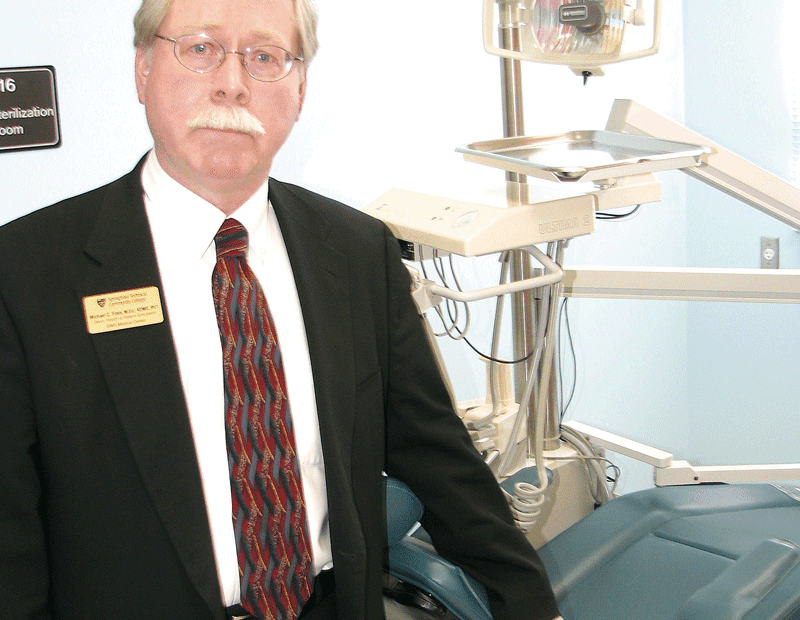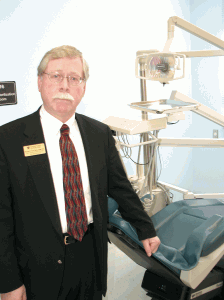
Curable Condition
Health Care Hiring Is Sluggish — for Now

Mike Foss calls the health care job market “cool,” but sees plenty of positive signs for current students.
Health care, an industry that accounts for about one in every six jobs in Massachusetts, has long been seen as recession-proof in the Bay State.
The extended economic downturn has tested that, with once-brisk hiring turning stagnant and hospitals across the Commonwealth resorting to freezes and layoffs. Yet, most industry-watchers see the current sluggishness as a temporary swing, if only because people will always need health care.
“Hiring has to pick up,” said Kelly Aiken, director of Health Care Initiatives for the Regional Employment Board of Hampden County. “The economy can’t change how much care people need.”
In fact, despite pockets of layoffs, employment in health fields has ticked up slightly since it essentially ground to a halt last year.
That’s good news to students studying in health programs at area colleges. The robust job market over the past decade has drawn increasing numbers of applicants to those programs, but recent graduates have been navigating scarcer prospects than those who entered the workforce several years ago. Still, there’s reason for optimism.
“Last year, there was definitely a reduction in job availability, and this was pretty much across a dozen fields of health,” said Michael Foss, dean of the School of Health and Patient Simulation at Springfield Technical Community College. “One department chair told me that, since January of this year, there has been an upward swing in job openings, and others were beginning to see that as well.”
That perception is borne out statewide. According to the Executive Office of Labor and Workforce Development, 486,000 people were employed in health care in January 2009, and the number rose to more than 494,000 in January 2010 before essentially plateauing there.
But as the Great Recession fades, optimists say, certain demographic truths will take hold — specifically, mass retirements by the Baby Boom generation, coupled with an overall aging of the population.
“This whole issue with the Baby Boomers retiring — that’s national, and it’s not industry-specific. But the opportunities to replace those retirees might be greater in health care,” said Jean Jackson, vice president for Workforce Planning at Baystate Health, the region’s top employer.
“People are living longer, and they’re going to need care,” she continued. “So you have a combination of people retiring and living longer, and they’re going to need more people to care for them.”
That adds up to what should be increasing opportunities for health care careers, but job seekers may face a far different landscape when it comes to how and where care is delivered. For this issue, BusinessWest examines some of those trends, and why many observers see the current slow job market as a curable condition.
Day by Day
Foss has observed the cycle of medical hiring long enough to recognize a downturn. “It’s not hot; it’s a cool employment environment,” he conceded.
Meanwhile, many of the available openings, in a number of fields, are for per-diem work, essentially part-time jobs without benefits, he explained. Yet, that’s not necessarily a negative trend.
“I know that in some fields, per-diem is actually highly desirable, especially for individuals with families, or they’re the second person working. They kind of like the idea of not being tied down to a rigid work schedule.”
In addition, “I think a lot of people see that as one way they can prove to an employer that they should be full-time,” he said. “And it’s an opportunity for them to see if this is the environment they want to be in, if it’s the right institution, right office, wherever. It almost gives you an automatic job interview because, when there’s a full-time opening, they see the good work you’re doing and that you’re the person they need to hire.”
But the full-time job openings are slowly increasing, Foss noted. “And Baystate, a very large system with multiple locations, is building a brand-new facility. So we know those jobs will be available in the future.”
Indeed, Baystate’s Hospital of the Future project, set to be completed in 2012, is only the largest of a flood of hospital expansions across the Pioneer Valley over the past decade. From Jackson’s perspective, Foss’ assessment of what that means for hiring is right on.
“You have to look at all the factors — turnover, what the retirement plans look like, what the potential growth will be,” Jackson said. “And when you factor it all in over the next 10 years, we are looking at a projection to hire 15,000 employees.”
However, she added, “many of these jobs in health care require specialized skills and training beyond high school, and that’s another trend: concerns about the availability of workers. At Baystate, part of our mission is to recruit from the local labor market, and our work with education, employers, and workforce-development organizations to find solutions has been absolutely critical.”
Economic development leaders have long been concerned about a ‘skills gap’ in certain career fields — health care and precision manufacturing are two often mentioned in those discussions — that leave available jobs unfilled, and potentially create a deterrent for new employers to locate in Western Mass.
The collaborative workforce projects Jackson alluded to range from the Community Based Job Training Grant, a $1.65 million grant from the U.S. Labor Department that will create awareness of and training opportunities in health fields, to Collaborating for the Advancement of Nursing: Developing Opportunities (CAN DO), a grant program aimed at creating career ladders in nursing. Numerous other regional programs have similar goals.
“Everyone is struggling with the economic environment now,” Jackson said. “Health reimbursements are down, patients are choosing not to do elective surgery, putting things off, and people are delaying retirement. But eventually, they’re going to retire.” And sooner than many realize, she continued, the region will need a strong pipeline of qualified workers to take their place.
Care Where It’s Needed
That future workforce will need to be flexible as well as skilled, Foss said.
“Where they work is going to be different. We’re already seeing a shift from always thinking they’ll work at a hospital. Look at all the long-term care facilities out there now. And the outpatient clinics — in my lifetime, I’d never heard of outpatient surgical centers. No way; you had to go to the hospital. But that’s another place where people will work outside of hospitals.”
Home care is expanding rapidly as well, he noted, again, a reflection of that growing senior population that wants to maintain as much independence as possible. In fact, according to the Bureau of Labor Statistics, opportunities for personal and home care aides will increase by 50% between 2006 and 2016.
“I do think that jobs are going to be located in different places,” Aiken said. “When the recession ends and the economy bounces back, coupled with health care reform, the trend across the continuum will be to deliver patient-centered care, and much of that care will be occurring in many, many different places outside of the hospital setting.
“People who go into nursing thinking their first job will definitely be in a hospital need to look beyond that. They need to look where care is being provided and where the need is.”
Foss said he’s encouraged by this changing face of health care.
“There are niches being filled that never used to be there, and all these wonderful things happening with new technology,” he told BusinessWest. “Even with the cool market, I think it’s an exciting time for health care.”
Aiken agreed. “I think there are going to be changes, new health care occupations that may evolve, that we don’t even know about right now.”
One thing is certain, though, Foss said: no one’s going to work forever, and opportunities will be abundant again.
“The Department of Labor and other pundits, they always come back to health care,” he said. “A lot of people in my age group will be retiring in three or four years, and those who have planned their retirement well — especially now, with health care reform — are going to be using the health care system.
“So while things may be a little cool at the moment,” he concluded, “there are still opportunities out there, and those opportunities are going to increase every single year for the foreseeable future.”
Joseph Bednar can be reached at
[email protected]





